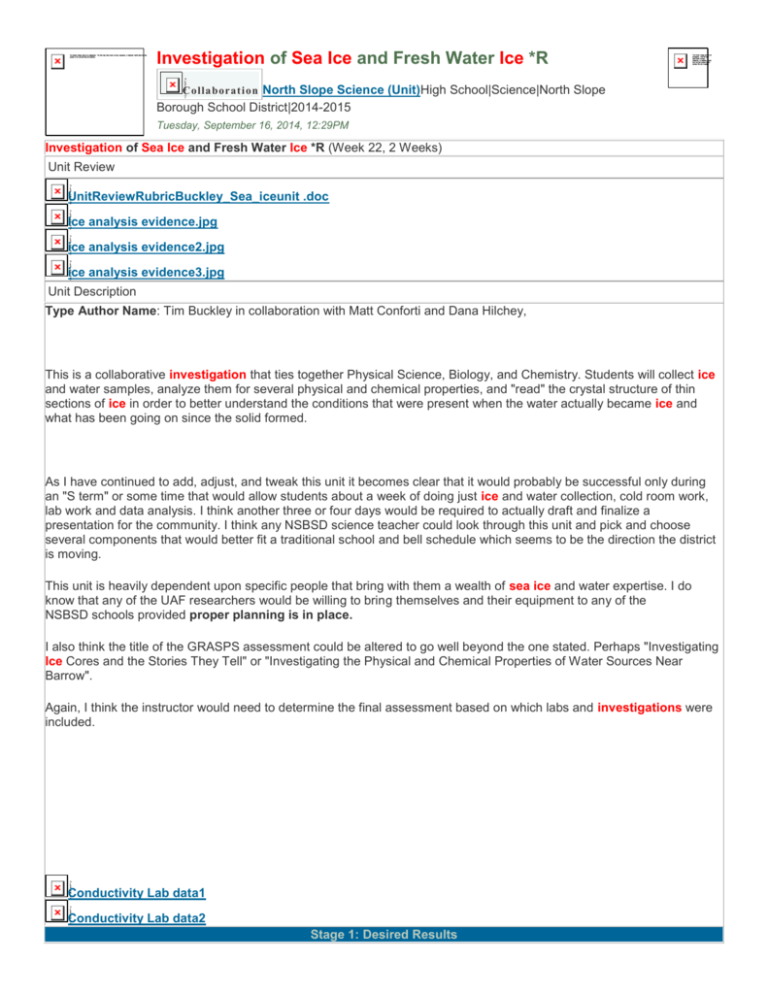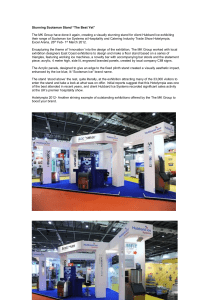
Investigation of Sea Ice and Fresh Water Ice *R
Col la borat i on North Slope Science (Unit)High School|Science|North Slope
Borough School District|2014-2015
Tuesday, September 16, 2014, 12:29PM
Investigation of Sea Ice and Fresh Water Ice *R (Week 22, 2 Weeks)
Unit Review
UnitReviewRubricBuckley_Sea_iceunit .doc
Ice analysis evidence.jpg
ice analysis evidence2.jpg
ice analysis evidence3.jpg
Unit Description
Type Author Name: Tim Buckley in collaboration with Matt Conforti and Dana Hilchey,
This is a collaborative investigation that ties together Physical Science, Biology, and Chemistry. Students will collect ice
and water samples, analyze them for several physical and chemical properties, and "read" the crystal structure of thin
sections of ice in order to better understand the conditions that were present when the water actually became ice and
what has been going on since the solid formed.
As I have continued to add, adjust, and tweak this unit it becomes clear that it would probably be successful only during
an "S term" or some time that would allow students about a week of doing just ice and water collection, cold room work,
lab work and data analysis. I think another three or four days would be required to actually draft and finalize a
presentation for the community. I think any NSBSD science teacher could look through this unit and pick and choose
several components that would better fit a traditional school and bell schedule which seems to be the direction the district
is moving.
This unit is heavily dependent upon specific people that bring with them a wealth of sea ice and water expertise. I do
know that any of the UAF researchers would be willing to bring themselves and their equipment to any of the
NSBSD schools provided proper planning is in place.
I also think the title of the GRASPS assessment could be altered to go well beyond the one stated. Perhaps "Investigating
Ice Cores and the Stories They Tell" or "Investigating the Physical and Chemical Properties of Water Sources Near
Barrow".
Again, I think the instructor would need to determine the final assessment based on which labs and investigations were
included.
Conductivity Lab data1
Conductivity Lab data2
Stage 1: Desired Results
ILF Overarching Understandings/Essential Questions
ILF Performance Expectations
ILF: Environmental Realm, K3-12, Tools
OU: A person needs to learn skills and technology that are
appropriate to his or her environment that enhances his or
her ability to explore and discover. [E.t.4]
ILF: Performance Expectations: Environmental Realm,
Practitioner, Tools
Personal skills and technology E.t.4
The student demonstrates the ability to use a variety of tools
for appropriate applications by . . .
EQ: How does the Arctic environment affect the
choice of skills and technology a person needs?
[E.t.4.a]
ILF: Historical Realm, K3-12, Modern History
OU: All change has roots in both immediate and long-term
past events, and branches into the future. [H.mh.5]
EQ: How can I learn the causes of contemporary
problems? [H.mh.5.a]
EQ: How can I predict the future effects of today's
actions and decisions? [H.mh.5.b]
[P] E.t.4.2 Assessing and evaluating the validity and
accuracy of information.
ILF: Performance Expectations: Historical Realm,
Practitioner, Modern History
Modern History, change has roots in the past and branches
to the future H.mh.5
The student demonstrates an understanding of the past
roots and future potential of historical knowledge by . . .
[P] H.mh.5.2 Enacting a plan for bringing about
positive change in the community or region.
Alaska State Standards
State Standards & GLEs
NGSS: Science Performance Expectations(2013), NGSS: HS Physical Sciences, HS.Structure and Properties of Matter
Performance Expectations
HS-PS1-3. Plan and conduct an investigation to gather evidence to compare the structure of substances at the
bulk scale to infer the strength of electrical forces between particles.
2012 ELA and Math Standards
6-12 Literacy in History/Social Studies, Science, and Technical Subjects (2012), Grades 11-12, Reading: Science &
Technical Subjects
KEY IDEAS AND DETAILS
RI.11-12.3 Follow precisely a complex multistep procedure when carrying out experiments, taking
measurements, or performing technical tasks; analyze the specific results based on explanations in the text.
Content Area Understandings & Essential Questions
Content Area OUs & EQs
Topical Understandings & Essential Questions
OU 1: The composition of sea water and fresh water
NSBSD: Science, K3-12, Physical Science
NSPS.1OU: All matter is made up of the same fundamental define their properties.
particles combined in different ways.
EQ 1: How does the composition of water affect its
properties?
NSPS.1.a EQ: What is the composition of matter?
NSPS.3OU: All matter has characteristic properties.
NSPS.3.a EQ: How do properties change when
matter is combined?
OU 2: Some properties of water can be visualized.
EQ 2: How does salinity affect the structure of crystals in
frozen water?
OU 3: Sea ice conditions are an integral part of Inupiat
subsistence activities.
EQ 3 How do changing sea ice conditions affect
subsistence activities?
Knowledge
Student will know...
the relationship between crystal structure and
salinity in different types of water.
chemical properties of water can be used to identify
its source (sea water, brackish/lagoon water, tap
water).
Inupiaq names for variety of ice types and the
changing ratios of first year ice to multiyear ice.
How the crystal structure of ice relates to its'
appearance and consequently the Inupiaq words
used to identify different ice types.
Skills
Students will be able to...
prepare frozen water samples for cross polarization
viewing.
identify water types (fresh, salt, brackish) based on
crystal structure of ice samples.
perform conductivity, salinity, and pH tests on water
samples.
communicate the potential impact of changing sea
ice conditions on subsistence activities.
correctly use Inupiaq words to identify different types
of ice found within an ice core and how the types
differ from one another in terms of formation and
dissolved solid content.
Stage 2: Assessment Evidence
Transfer Task(s) (Performance Assessments)
At least one assessment in GRASPS form.
Summative: Performance (GRASPS)
Your chemistry class has been volunteered by your teacher to create a presentation that will be delivered as a Saturday
Science Talk at the Barrow Arctic Research Center. The topic of the presentation is "Observable Differences in Sea Ice
and Fresh Water Ice and the Stories They Tell" (DOK 4).
You will need to collect ice samples from near shore sea ice, the lagoon behind the high school, water samples from
BUECI and tap water (DOK 1). Ice samples from all three sources will be tested for salinity, conductivity, and pH (DOK 2).
Furthermore, thin sections of each ice type will be observed through cross polarized filters in order to observe and record
differences in crystal structure (DOK 2). Ice Data will be analyzed in order to hypothesize the conditions present during
freeze up and the "story" of the ice since that time
(DOK 3).
Collected data and observations will be compiled into a Power Point/Keynote presentation that will be used at the
Saturday Science Talk(DOK 2). Included in the presentation will be procedures, data, charts, graphs, and overall
conclusion of the results of the investigation. The presentation will include Inupiat names for the different ice structures
observed within the core and explanations of the environmental conditions present during the formation of different ice
layers. Students presentations will include a projection of sea ice conditions for the near future based on past data and
current Global Climate Change models.
Evaluative Criteria
Other Evidence (Graded)
Clarity of Presentation
Accuracy of data presented
Presentation covers all areas of the
investigation
(ice, lab, research)
Cooperative work skills
Lab procedures and skills
Ice Properties Unit Rubric[1].docx
DART Rubric
collaborative group work skills rubric
Oral Presentation Rubric (optional)
Computer research on changing sea ice
conditions (DOK 2)
(graded on 0-5 scale for on task and product
completion)
Collect ice and water samples from various sources
(DOK 1) (participation grade)
Comparison of data collected with probes from
different samples (DOK 3)
Construct a lab notebook (sketches, procedures,
speaker notes) (DOK 1)
Ice Core analysis (DOK 3)
Stage 3: Learning Plan
Learning Experiences (in order of implementation)
1. Collecting ice cores on near shore sea ice and proper
handling of ice samples (preparing and using a core barrel
and jiffy motor)
2. Drilling holes in the middle lagoon in order to collect water
(preparing and using an ice auger, drill motor, and
generator)
Checking for Understanding (Ungraded)
1. Continuous Q/A with students during all parts of the
activity.
2. Appropriate behavior during guest speakers
presentation.
3. Ice core collection (procedure).
4. Pre & post lab Q/A & Discussion.
5. Cold room ice work/equipment operatiom
3. Guest speaker (Richard "Savik" Glenn): Deciphering Ice
Cores and Traditional Ice Knowledge
4. Slice cores into thin sections investigate crystal structure
using cross polarized filters.
5. Tour of the BEUCI water treatment facility and collect
samples of water from various spigots within the facility
6. Chemistry Lab to measure conductivity, total dissolved
solids (TDS), and pH of various water samples.
Resources and Preparation Materials
Ice Structure materials from NSBSD North Slope Science Curriculum materials binder
Conductivity Lab materials
National Snow & Ice Data Center: Background info on sea ice formation.
UAF research paper on crx formation and interpreting crx strucutre
Lab instructions for using polarizing filters to view crx structure
Student level web site on sea ice formation
Thermohaline conveyor web site (NASA/Earths Oceans)
Daily Lesson Plans
SIKU by Krupnik, Aporta, & Gearheard
Conductivity measurement info
Answers to lab questions
Ice Unit Rubric
Conductivity lab background info
National Snow & Ice Data Center
Lab on using polarizing filters to view crx structure
water treatment crossword puzzle
answers to crossword puzzle
Student Sea Ice background information
Info on Earths Ocean conveyor system
Daily lesson plans
Sea Ice Crx formation
©
Last Updated: Friday, August 1, 2014, 1:28PM
Atlas Version 8.0.4
© Rubicon International 2014. All rights reserved









